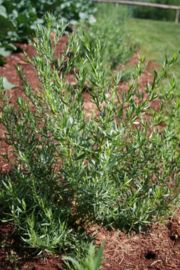Artemisia dracanculus sativa - French Tarragon
Scientific Name: Artemisia dracunculus sativa
Common Name: French Tarragon
The species Artemisia dracunculus has been in English gardens since the sixteenth century and appeared in American gardens before the American Revolution.[1]
Thomas Jefferson first encounted tarragon while living in Paris. When he returned to the United States, he discovered that tarragon was hard to find. He made several inquiries to locate seeds, but seeds were scarce since plants used for cooking and vinegar rarely produced seeds. People propagated tarragon from cuttings and root division.[2] In April 1806, Jefferson wrote to Philadelphia nurseryman Bernard McMahon that he had been "many years endeavoring to get some seed of the Tarragon, but without success."[3] McMahon promptly replied with a shipment of roots on April 30.[4]
In 1809, Jefferson recorded that tarragon was planted at Monticello in a bed at the garden's northwest border on April 12, but the tarragon "failed."[5] In 1812, he noted its transplanting in Square XVII of the garden.[6] He also documented the planting of tarragon in 1813 and 1814.[7]
French Tarragon is a hardy perennial herb with edible, aromatic foliage. Its popularity with Jefferson most likely comes from the fact that this herb is essential in French cuisine like Bearnaise sauce, vinegars, and fish and chicken dishes. An example of this popularity is Jefferson's vinaigre d'estragon where three pints of vinegar was added to one quart of partially dried tarragon leaves. After one week, it was strained, bottled, and corked.
Primary Source References
1793 March 10. (Jefferson to J.P.P. Derieux). "The estragon (called in English Tarragon) is little known in America."[8]
1805 October 12. (Jefferson to J. Phillipe Reibelt). "[T]here is a garden plant of France which I have never been able to get, the Estragon. perhaps mr. Labullaye could furnish me a little of the seed."[9]
1806 April 25. (Jefferson to Bernard McMahon). "TH:J has been many years endeavoring to get some seed of the Tarragon, but without success."[10]
1806 April 30. (Bernard McMahon to Jefferson). "It gives me much pleasure to have it in my power to send you a few roots of the Artemisia Dracunculus, or Tarragon, these I forwarded by yesterday’s mail and hope you will receive them in good condition; they propagate very freely and abundantly by the roots, and are perfectly hardy, requiring no additional care or protection in winter."[11]
1806 July 12. (Bernard McMahon to Jefferson). "I am desirous to know if the Tarragon plants have succeeded, as, if necessary, I will send you a further supply."[12]
1807 December 22. (Jefferson to J. Phillipe Reibelt). "Your favor of Oct. 25. with the seed of the wild Estragon came to hand last night for which I now return you my thanks."[13]
1809 January 17. (Bernard McMahon to Jefferson). "I wish to know if the Tarragon roots I sent you have succeeded as I can send you a supply in due time this season if they failed."[14]
1809 October 11. (Jefferson to William Thornton). "[T]he tarragon you were so kind as to send me is now growing with the former bunch."[15]
1812 June 1. (Jefferson to J. Peter Derieux). "Your favor of May 11. is just recieved, with the seeds & roots of the Tarragon, for which I return you my thanks. the root had become entirely dry & without any principle of vegetation left in it. this was the less important, as I had some years ago succeeded in obtaining the plant from N. Orleans where it grows wild."[16]
- Peter Hatch
Further Sources
- Garden Book, 1766-1824, by Thomas Jefferson [electronic edition]. Thomas Jefferson Papers: An Electronic Archive. Boston: Massachusetts Historical Society, 2003.
- McMahon, Bernard. The American Gardener's Calendar, 1806 (Charlottesville: Thomas Jefferson Memorial Foundation, 1997). See pages 11, 198, and 511.
- Thomas Jefferson Center for Historic Plants.
References
- ^ Alice M. Coats, Flowers and Their Histories (London: Black, 1968), 277.
- ^ Coats, Flowers and Their Histories, 280.
- ^ Jefferson to McMahon, April 25, 1806, Thomas Jefferson Papers, Library of Congress. Transcription available at Founders Online.
- ^ McMahon to Jefferson, April 30, 1806, Thomas Jefferson Papers, Library of Congress. Transcription available at Founders Online. See also Betts, Garden Book, 318-19.
- ^ Garden Book, 1766-1824, page 35, by Thomas Jefferson [electronic edition], Thomas Jefferson Papers: An Electronic Archive (Boston: Massachusetts Historical Society, 2003). See also Betts, Garden Book, 388.
- ^ Garden Book, 1766-1824, page 46, by Thomas Jefferson [electronic edition], Thomas Jefferson Papers: An Electronic Archive (Boston: Massachusetts Historical Society, 2003). See also Betts, Garden Book, 470.
- ^ Garden Book, 1766-1824, page 53, page 54, by Thomas Jefferson [electronic edition], Thomas Jefferson Papers: An Electronic Archive (Boston: Massachusetts Historical Society, 2003). See also Betts, Garden Book, 500, 522.
- ^ PTJ, 25:347. Transcription available at Founders Online.
- ^ Thomas Jefferson Papers, Library of Congress. Transcription available at Founders Online. See also Betts, Garden Book, 305.
- ^ Thomas Jefferson Papers, Library of Congress. Transcription available at Founders Online. See also Betts, Garden Book, 313.
- ^ Thomas Jefferson Papers, Library of Congress. Transcription available at Founders Online. See also Betts, Garden Book, 318-19.
- ^ Thomas Jefferson Papers, Library of Congress. Transcription available at Founders Online. See also Betts, Garden Book, 322.
- ^ Thomas Jefferson Papers, Library of Congress. Transcription available at Founders Online. See also Betts, Garden Book, 356.
- ^ Thomas Jefferson Papers, Library of Congress. Transcription available at Founders Online. See also Betts, Garden Book, 402.
- ^ PTJ:RS, 1:600. Transcription available at Founders Online.
- ^ PTJ:RS, 5:98. Transcription available at Founders Online. See also Betts, Garden Book, 488. French tarragon does not grow well in high heat and humidity, but the Russian variety does.
